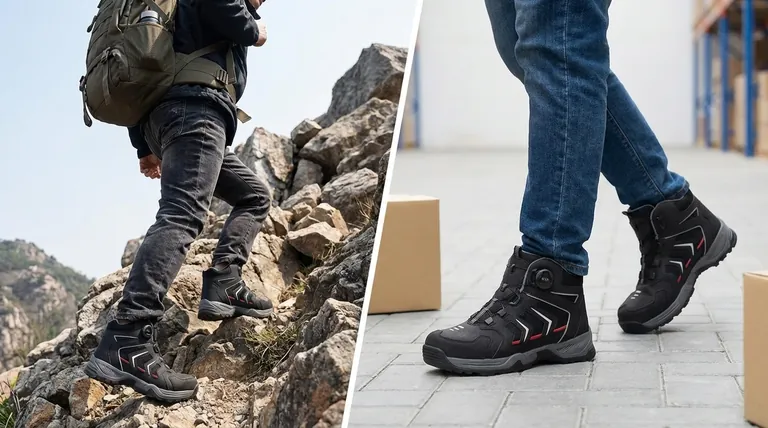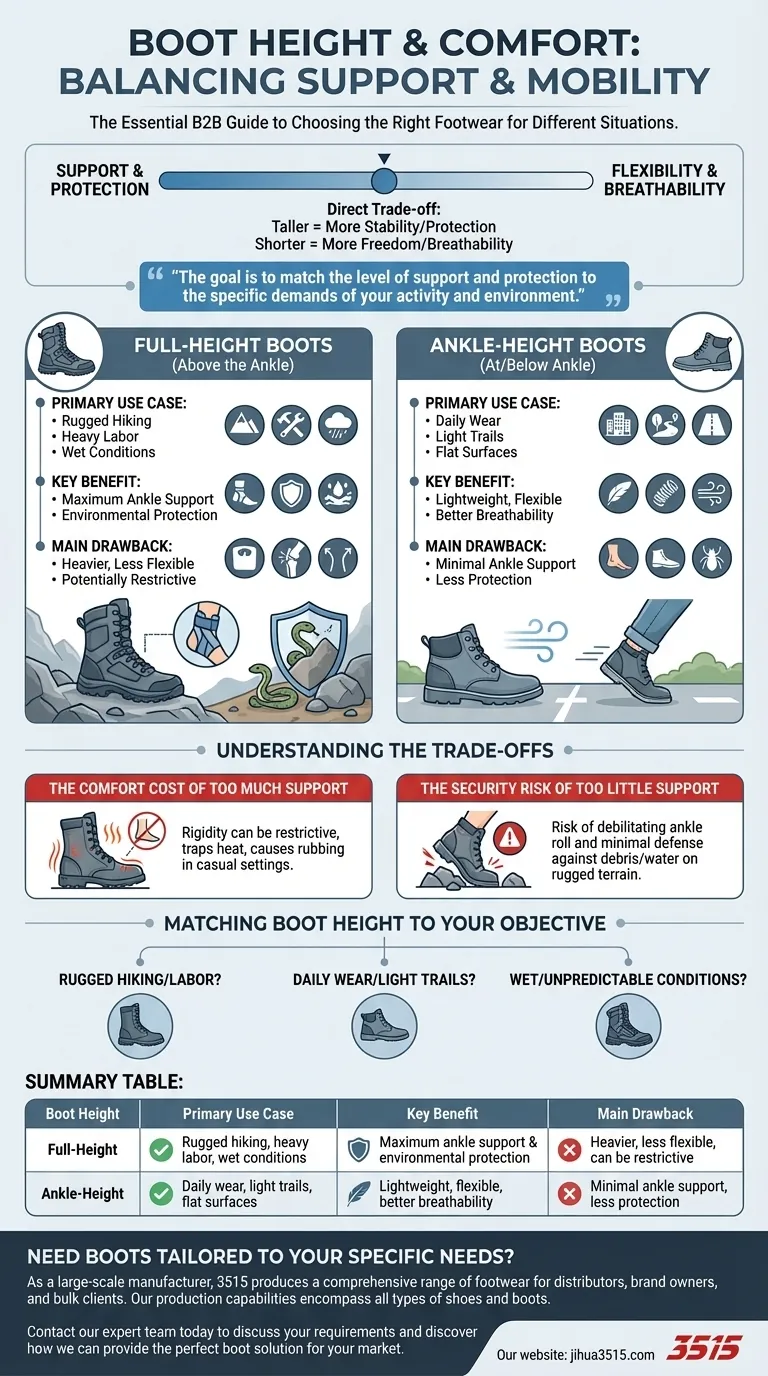In short, boot height directly trades ankle support and protection for flexibility and breathability. Taller boots offer maximum stability for rugged terrain at the cost of being heavier and potentially more restrictive, while shorter boots provide greater freedom of movement for everyday wear but offer minimal protection against twists or environmental hazards.
The question isn't which boot height is universally "more comfortable." The real goal is to match the level of support and protection to the specific demands of your activity and environment.

The Core Principle: Support vs. Mobility
Choosing a boot height is fundamentally about managing the relationship between your ankle and the ground you're covering. The height of the boot's shaft determines how much control it exerts over your ankle's movement.
The Role of the Boot Shaft
The shaft is the part of the boot that extends up from the foot. Its primary functions are to stabilize the ankle joint and shield the lower leg from impacts, abrasions, and the elements.
How Height Influences Ankle Stability
Taller, full-height boots act as an external brace. They physically limit the ankle's ability to roll or twist, which is critical when navigating uneven, rocky, or unstable ground, especially while carrying weight.
The Impact on Freedom of Movement
Ankle-height boots end at or below the ankle bone. This design allows for a full, natural range of motion, making them feel less restrictive and more comfortable for activities on predictable surfaces like paved paths or light trails.
Analyzing the Two Primary Categories
While there are many variations, most boots fall into two general height categories, each optimized for different conditions.
Full-Height Boots (Above the Ankle)
These boots are engineered for demanding situations. Their taller shaft provides superior support, protecting you from sprains when you're fatigued or carrying a heavy pack.
This height also offers significantly more protection from deep mud, water, snow, and hazards like snake bites or sharp rocks. They are the standard for serious hiking, construction, and tactical applications.
Ankle-Height Boots (At or Below the Ankle)
These shorter boots prioritize lightweight comfort and flexibility. They are often preferred for general daily wear, work in controlled environments, and hiking on well-maintained trails.
Their lower cut allows for better heat dissipation, making them a more comfortable choice in warmer weather. The lack of a high shaft means less potential for chafing on the calf during long walks.
Understanding the Trade-offs
No single boot height is perfect for every scenario. Understanding the inherent compromises is key to making an informed decision.
The Comfort Cost of Too Much Support
Wearing a full-height boot in a casual setting can be counterproductive. The rigidity can feel restrictive, and the added material traps heat. On long, flat walks, the repetitive motion against a stiff upper can cause uncomfortable rubbing or chafing.
The Security Risk of Too Little Support
Using an ankle-height boot on rugged terrain exposes you to significant risk. It offers almost no protection from a serious ankle roll, which can be debilitating far from help. They also provide minimal defense against deep water or debris entering the boot.
Matching Boot Height to Your Objective
Base your choice on the most demanding conditions you realistically expect to face.
- If your primary focus is rugged hiking, hunting, or heavy labor: You require the superior ankle support and environmental protection of a full-height boot.
- If your primary focus is daily wear, light trail walking, or work on flat surfaces: An ankle-height boot provides the ideal balance of flexibility, low weight, and all-day comfort.
- If your primary focus is navigating wet, snowy, or unpredictable conditions: A taller boot is non-negotiable for keeping your feet dry and protected from the elements.
Choosing the right boot height is the foundation for secure, comfortable movement in any environment.
Summary Table:
| Boot Height | Primary Use Case | Key Benefit | Main Drawback |
|---|---|---|---|
| Full-Height (Above Ankle) | Rugged hiking, heavy labor, wet conditions | Maximum ankle support & environmental protection | Heavier, less flexible, can be restrictive |
| Ankle-Height (At/Below Ankle) | Daily wear, light trails, flat surfaces | Lightweight, flexible, better breathability | Minimal ankle support, less protection |
Need Boots Tailored to Your Specific Needs?
As a large-scale manufacturer, 3515 produces a comprehensive range of footwear for distributors, brand owners, and bulk clients. Whether you require the rugged support of full-height boots for demanding environments or the flexible comfort of ankle-height boots for everyday use, our production capabilities encompass all types of shoes and boots.
Contact our expert team today to discuss your requirements and discover how we can provide the perfect boot solution for your market.
Visual Guide

Related Products
- Wholesale Safety Footwear Manufacturer for Bulk & Custom OEM Orders
- Premium Flame-Retardant Waterproof Safety Boots and Shoes
- Premium Wholesale Wheat Nubuck Safety Boot with Rapid Lacing System
- Premium Grain Leather Safety Boots for Bulk Supply
- Premium Wholesale Waterproof Safety Boots High Performance Protection for Industrial Markets
People Also Ask
- What are the differences between steel toe, composite toe, and alloy toe Wellington boots? Choose the Right Safety Toe for Your Job
- Do moc toe boots have steel toe? Get Durable, Safety-Compliant Footwear
- Why is manufacturer diversity and inclusion important in work boot design? For Superior Fit, Safety & Comfort
- What's the difference between safety toe and steel toe? Choose the Right Protective Footwear.
- How do safety shoes contribute to cost savings for companies? A Strategic Investment in Risk and Cost Management



















